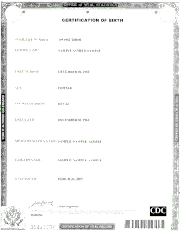Not true. The Birth Record (commonly known as a Birth Certificate) has much more information than a short-form Certification of Live Birth. Click here for more information.
From Wikipedia (please pardon me for not reformatting it all):
Birth certificates in the United States
Long forms
Long forms, also known as certified photocopies, book copies, and photostat copies, are exact photocopies of the original birth record that was prepared by the hospital or attending physician at the time of the child's birth [2]. The long form usually includes parents' information (address of residence, race, birth place, date of birth, etc.), additional information on the child's birthplace, and information on the doctors that assisted in the birth of the child. The long form also usually includes the signature of the doctor involved and at least one of the parents [3].
In the U.S., the U.S. National Center for Health Statistics creates standard forms that are recommended for long form birth certificate use. However, states are free to create their own forms [4]. These "forms" are completed by the attendant at birth or a hospital administrator, which are then forwarded to a local or state registrar, who stores the record and issues certified copies when requested [5].
Long forms may become obsolete in years to come, as many states have begun to use Electronic Birth Registration systems [6]. The use of these systems will enable information typically seen on certified copies (long forms) to be available in computer databases that typically issue short form certificates, thus eliminating the need for "hard copy" long form certificates and having all birth information stored in computer databases only. This benefits parents in many ways; registration can be completed via computer at the hospital, meaning that parents can stop by their Vital Statistics office on the way home from the hospital to purchase the birth certificate instantly [7]. It also means that the extra cost for long form certificates will no longer be a factor.
[edit] Short forms
Short forms, known sometimes as computer certifications, are not universally available, but are cheaper than photocopies and much more easily accessible. Limited information is taken from the original birth record (the long form) and stored in a database that can be accessed quickly when birth certificates are needed in a short amount of time. Whereas the long form is a copy of the actual birth certificate, a short form is a document that certifies the existence of such certificate, and is usually titled a "Certification of Birth" or "Certificate of Birth Registration". The short form typically includes the child's name, date of birth, sex, and place of birth, although some also include the names of the child's parents. When the certification does include the names of the parents, it can be used in lieu of a long form birth certificate in almost all circumstances [2]. Nearly all states in the U.S. issue short forms certifications, on both state and local levels [8].
[edit] Other forms
In addition to short forms and long forms, many registration authorities also have wallet-sized short form birth certifications available, and apostille/exemplified certifications which are hand signed by the registrar and are to be used when being presented before the government of a foreign country, pursuant to the 1961 Hague Convention. Other registration authorities will even issue commemorative certificates, many of which are legal certifications of birth [9].
Most hospitals in the U.S. issue a souvenir birth certificate which typically includes the footprints of the newborn. However, these birth certificates are not legally accepted as proof of age or citizenship, and are frequently rejected by the Bureau of Consular Affairs during passport applications. Many Americans believe these souvenir records to be their official birth certificate, when in reality it holds little legal value [10].

